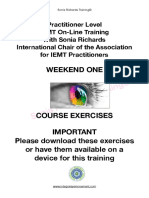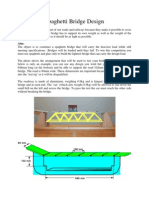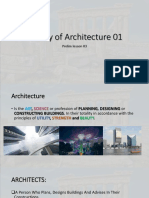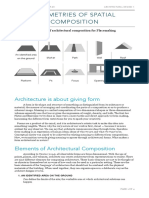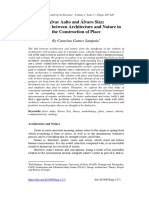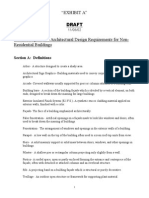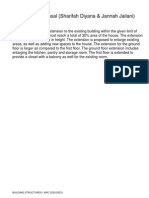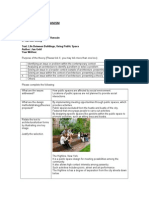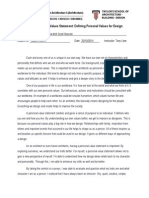0 ratings0% found this document useful (0 votes)
136 viewsProject 1: Understanding Forces in Skeletal Structures
1) The project required building a skeletal load-bearing structure using only popsicle sticks, toothpicks, threads and pins that could withstand a minimum load of 1.25kg.
2) Different joining methods were explored, including tying sticks with strings, interlocking, using pins. The final structure combined methods using pins and strings.
3) Load testing was conducted in phases up to 12.5kg before failures began to occur in the joints and bracings. Analysis found V-bracing best distributed loads down the structure.
Uploaded by
diyanahussainCopyright
© © All Rights Reserved
Available Formats
Download as PPTX, PDF, TXT or read online on Scribd
0 ratings0% found this document useful (0 votes)
136 viewsProject 1: Understanding Forces in Skeletal Structures
1) The project required building a skeletal load-bearing structure using only popsicle sticks, toothpicks, threads and pins that could withstand a minimum load of 1.25kg.
2) Different joining methods were explored, including tying sticks with strings, interlocking, using pins. The final structure combined methods using pins and strings.
3) Load testing was conducted in phases up to 12.5kg before failures began to occur in the joints and bracings. Analysis found V-bracing best distributed loads down the structure.
Uploaded by
diyanahussainCopyright
© © All Rights Reserved
Available Formats
Download as PPTX, PDF, TXT or read online on Scribd
You are on page 1/ 15
PROJECT 1
Underst andi ng Forces i n Skel et al St ruct ures
G R O U P ME MB E R S
J a n n a h J a i l a n i ( 0 3 1 0 2 1 0 )
M e e r a N a z r e e n ( 0 3 0 9 6 3 0 )
S h a r i f a h D i y a n a ( 1 0 0 6 A H 7 8 3 7 3 )
S o h Y o u S h i n g ( 0 3 0 8 3 1 0 )
S u r a y y n S e l v a n ( 0 3 0 9 8 1 8 )
BUILDING CONSTRUCTION 2
[ ARC 2513 ]
C ON T E N T PA GE
I NT RODUCT I ON
DESI GN CONCEPT
PHASES
EXPLORATI ON
JOINT SYSTEMS
LOAD BEARING SYSTEMS
CONSTRUCTI ON
LOAD TESTI NG
ANALYSI S
LOAD DISTRIBUTION
TIME LAPSE
RESULTS
CONCL USI ON
I N T R OD U C T I ON
This project required us to produce a skeletal load bearing structure that can stand up
to a minimum of 1.25kg load. The materials used, however, were limited to popsicle
sticks, toothpicks, threads and pins. No adhesive materials were allowed and the
structure was to stand on top of an A5 base. The number of popsicle sticks were
limited to 100 pieces only. Once the structure has been completed, it must be tested
and an analysis in the form of a report must be produced.
D E S I GN C ON C E P T
The design concept of our structure was a result from researching and analyzing
different types of braces possible with the use of popsicle sticks. Due to the
prohibition of using any adhesive material, different methods have been
experimented and applied to the structure in order to achieve the maximum
strength and bearing weight.
The key elements that were highlighted and included:
1. Joints Suitable joining methods to hold the structure together that allows a
higher load to be bore.
Example: Pins, string
2. Form The form of the structure is a consequence of the shapes used as the
base of the structure.
Example: Triangle, square
1. Bracing Proper and sturdy bracing allows the load to be distributed equally
between parts, providing the structure with stability and strength.
Example: V-bracing
P H A S E S
E X P L O R A T I O N
J O I N T I N G S Y S T E M S
Method 1
Popsicle Sticks Tied With Strings
With Bracings
Connecting the popsicle sticks using
string allows flexible joining among the
popsicle sticks. The bracing actually
helps to strengthen the joint system.
Method 2
Interlocking Popsicle Sticks
Interlocking the popsicle sticks is
strong as it can withstand high
pressure but it can only be done in
certain angle (90 degree).
Method 3
Popsicle Sticks Tied With Strings
With A Cut Hole
This method is not as efficient as the
previous two methods as the strings
came off easily and the cut hole is not
really helping the popsicle sticks to be
tied together with the string.
P H A S E S
E X P L O R A T I O N
J O I N T I N G S Y S T E M S
Method 4
Popsicle Sticks Connected Using
Pin
The pin helps the joints to held closely
together but the popsicle sticks crack
slight especially under high tension.
The Combination Method
Popsicle Sticks Connected Using
Pin And String
Using pin and string to tie the popsicle
sticks make it much stronger although
there is still a slightly crack on the
popsicle sticks.
The Combination Method
Cross Bracing Using Pin And String
For the bracing part, we decided to use
string to tie the popsicle sticks together
and also connecting it using pin and
bend the excess pin. It helps the
bracing to be held together closely.
P H A S E S
E X P L O R A T I O N
L O A D B E A R I N G S Y S T E M S
1. VERTICAL LOAD BEARING SYSTEM
The vertical force that acts on the structure is called the
compression force. This force squashes the structure, shortening
it. The vertical members intend to transfer the load to the
structures below.
2. HORIZONTAL LOAD BEARING SYSTEM
The horizontal force acting upon the structure is called the tension
force. The horizontal members of the structure intend to transfer
this tension downwards to the member below it.
3. ARCHED LOAD BEARING SYSTEM
The structure that is subjected to both compression and tension
force is being bent. When compressed, the arch functions as a
system in which the load is transferred equally throughout the
structure.
From top left, anti-clockwise:
Cross bracing structure, V- bracing structure, arch
member, digital model of a v-shaped structure,
triangular shaped member
Acting Load
Compression Force
Tension Force
P H A S E S
C O N S T R U C T I O N
Step 1
Connecting Main Component
Connecting the popsicle sticks by
using pins to strengthen the joint
system and creating a modular
component. The bracing helps in
supporting the component.
Step 2
Reinforcing Main Component
The joints are then reinforced by tying
of strings . This makes the component
stronger and more stable.
Step 3
Slotting Of Components
The components are then slotted
together. The pins are slotted in
between the popsicle sticks of another
component.
P H A S E S
C O N S T R U C T I O N
Step 4
Connecting square component
Four modular components are slotted
together to form a square base. This
strengthens the form of the tower.
Step 5
Reinforcing square component
The square components are then
reinforced by tying strings at all of the
joints. This stabilizes the square form.
Step 6
Building the tower
Three square modular components are
then placed on top of each other to
create a tower. The joints are then
reinforced and tied together by using
strings.
P H A S E S
L O A D T E S T I N G
FINAL WEIGHT OF EACH TEST:
1
ST
TEST 6.6 KG
2
ND
TEST 7.5 KG
3
RD
TEST 12.5 KG
The initial testing was to test our base structure which consisted of V bracing in the middle of each sides. The popsicle sticks were connected
and reinforced with threads as well as pins on each end. This test was conducted by using laptops and a bottle full of water. At the weight of 6.6
KG, the structure had leaned towards its side due to the lack in strength of the threads.
F I R S T T E S T
1.2 KG 2.4 KG 3.6 KG 6.6 KG BASE STRUCTURE
The second testing was done to a 3 level of the similar structure in the first trial with actual weight load. However each structure was not tied up
or connected together. The middle structure was placed upside down for a better load flow. At the weight of 7.5KG, the structure started to
wobble. The testing was stopped as the structure cannot support anymore weight as they were not connected properly. Nevertheless, the tying
method of the thread has been reinforced and standardized for each part.
S E C O N D T E S T
2.5 KG 5 KG 6.25 KG 7.5 KG
The final testing for the structure has been done after all of the 3 structures were connected properly with a proper tying with the thread on each
4 sides. On the initial for this testing started off with a 2 KG of weight which progressively increases up until it reached 12.5 KG.
T H I R D T E S T
P H A S E S
L O A D T E S T I N G
2.5 KG 5 KG 7.5 KG 10 KG 11.25 KG 12.5 KG
A N A LY S I S
L O A D D I S T R I B U T I O N
After analysis, we concluded that the V-bracing would be the best fit for our structure. This is
because of the point load area that is located at the top that transfers the load equally to the
next modular structure located below. The square base gives more area for the load to be
distributed to the ground.
TENSION FORCE
COMPRESSION FORCE
1 2 2
3
Popsicle stick 1 transfers the loads horizontally to the
vertical popsicle sticks 2. While this happens, the load
transfers equally to popsicle stick V-bracing 3.
1 2
3 3
The compression force acting on popsicle stick 1, is
transferred downwards vertically. The load applied to point
2, is transferred equally on the V-bracing towards popsicle
stick 3, which is horizontal.
A N A LY S I S
T I M E L A P S E
Weight (kg)
2.5 5.0 7.5 10.0
Changes To The
Structure
Weight (kg)
12.0 14.0 16.0 18.0
Changes To The
Structure
A N A LY S I S
R E S U L T S
Failure 1
The popsicle stick detached from the
tower as the pin was not strong enough
due to high tension. In order to
overcome this problem, we could drill
the holes instead of using hammer.
This method will prevent the popsicle
sticks to crack.
Failure 2
The string was loosen which caused
the bracing to split. The solution for this
is by using toothpick so that the
popsicle sticks can be attached tightly.
Thus, the bracing will be strong
enough.
Failure 3
The tower lost its balance as the
bracing was split as shown and
causing it to fall. One way to solve this
is by making the base more stable,
example creating a bigger base,
change the way of bracing, etc.
C ON C L U S I ON
By completing this project, we have a deeper understanding towards the importance
of building construction in architectural design. We are able to explore construction
design, structural analysis, skeleton strength and load distribution through this project.
This gives us knowledge on different joint methods and how each structure reacts to a
system. Every single structure in a system is as equally important to make it stand.
Through constructing structures and load testing, we were able to learn important
points that would help improvise our final structure.
You might also like
- Sonia Richards - Week End 1 - Course Exercice100% (1)Sonia Richards - Week End 1 - Course Exercice10 pages
- Understanding Forces in Skeletal StructureNo ratings yetUnderstanding Forces in Skeletal Structure6 pages
- Building Con 1 bld60303 Project 2 Brief - August 2016No ratings yetBuilding Con 1 bld60303 Project 2 Brief - August 20164 pages
- Lecture 4 - Out Door Space and Its CharcteristicsNo ratings yetLecture 4 - Out Door Space and Its Charcteristics31 pages
- Theory of Design I: Introduction To ArchitectureNo ratings yetTheory of Design I: Introduction To Architecture43 pages
- A Winding Wall Which Creates No Urban Barries For The Community As Well As The Individual.No ratings yetA Winding Wall Which Creates No Urban Barries For The Community As Well As The Individual.6 pages
- Relation of Form To Structure (Repaired)No ratings yetRelation of Form To Structure (Repaired)13 pages
- ENDS 3271 Architecture Design Project - Course Outline - EUI 2023No ratings yetENDS 3271 Architecture Design Project - Course Outline - EUI 20238 pages
- Housing Exibility Problem: Review of Recent Limitations and SolutionsNo ratings yetHousing Exibility Problem: Review of Recent Limitations and Solutions12 pages
- Department of Architecture, College of Engineering, Andhra University. Detailed SyllabusNo ratings yetDepartment of Architecture, College of Engineering, Andhra University. Detailed Syllabus35 pages
- AD1 Elements of Architectural Composition For Placemaking PDF100% (1)AD1 Elements of Architectural Composition For Placemaking PDF4 pages
- Architectural Design Guidelines November 1102No ratings yetArchitectural Design Guidelines November 11028 pages
- Project 1 Brief Bmaterials August 2015 1No ratings yetProject 1 Brief Bmaterials August 2015 13 pages
- AY20-21 - CE - E2 - SEM1 - BP&D - EST-REM - Oct 18, 2021 - QPNo ratings yetAY20-21 - CE - E2 - SEM1 - BP&D - EST-REM - Oct 18, 2021 - QP6 pages
- School of Architecture and Planning: Anna University Chennai 25 Department of ArchitectureNo ratings yetSchool of Architecture and Planning: Anna University Chennai 25 Department of Architecture5 pages
- Axonometric & Oblique Projection With Example100% (1)Axonometric & Oblique Projection With Example37 pages
- Week 6 Reading Comprehension - Architecture Preliminary DesignNo ratings yetWeek 6 Reading Comprehension - Architecture Preliminary Design6 pages
- Bafna 2003 Space Syntax A Brief Introduction To Its Logic and Analytical TechniquesNo ratings yetBafna 2003 Space Syntax A Brief Introduction To Its Logic and Analytical Techniques14 pages
- 4.401 Architectural Building Systems - Course SyllabusNo ratings yet4.401 Architectural Building Systems - Course Syllabus4 pages
- Alfred Preis Displaced: The Tropical Modernism of the Austrian Emigrant and Architect of the USS Arizona Memorial at Pearl HarborFrom EverandAlfred Preis Displaced: The Tropical Modernism of the Austrian Emigrant and Architect of the USS Arizona Memorial at Pearl HarborNo ratings yet
- Building Structures (ARC 2523) Project 1 Fettuccine Truss BridgeNo ratings yetBuilding Structures (ARC 2523) Project 1 Fettuccine Truss Bridge21 pages
- Extension of An R.C Bungalow: Project 2No ratings yetExtension of An R.C Bungalow: Project 213 pages
- Intro To Business Exercise 1 and Exercise 2No ratings yetIntro To Business Exercise 1 and Exercise 23 pages
- Physics Lesson Notes On Heat Capacity and Specific Heat CapacityNo ratings yetPhysics Lesson Notes On Heat Capacity and Specific Heat Capacity5 pages
- Standard Solutions: Innovative Fluid PowerNo ratings yetStandard Solutions: Innovative Fluid Power70 pages
- Fork Lift Preventive Maintenance 3 Checklist: Carwill Construction IncNo ratings yetFork Lift Preventive Maintenance 3 Checklist: Carwill Construction Inc2 pages
- Blending Aggregate Stockpiles: Senior/Graduate HMA CourseNo ratings yetBlending Aggregate Stockpiles: Senior/Graduate HMA Course17 pages
- Class Schedule Sy 2021 2022 Senior High SchoolNo ratings yetClass Schedule Sy 2021 2022 Senior High School2 pages
- To Identify Specific Information in A TextNo ratings yetTo Identify Specific Information in A Text7 pages
- Kiggundu - 1983 - Task Interdependence and Job Design Test of A TheNo ratings yetKiggundu - 1983 - Task Interdependence and Job Design Test of A The28 pages
- H.K. Moffatt - Cosmic Dynamos: From Alpha To OmegaNo ratings yetH.K. Moffatt - Cosmic Dynamos: From Alpha To Omega5 pages
- Oil Company or Service Company - OffshoreNo ratings yetOil Company or Service Company - Offshore11 pages
- Tom Dieck, M. C., & Jung, T. (2017) Value of Augmented Reality at Cultural Heritage Sites a Stakeholder ApproachNo ratings yetTom Dieck, M. C., & Jung, T. (2017) Value of Augmented Reality at Cultural Heritage Sites a Stakeholder Approach2 pages
- Answer:: A: A Selection Text. B: A Basic List Row. C: A Page FooterNo ratings yetAnswer:: A: A Selection Text. B: A Basic List Row. C: A Page Footer21 pages
- Master's Degree Programme in Sociology: Assignment July 2018 and January 2019 SessionsNo ratings yetMaster's Degree Programme in Sociology: Assignment July 2018 and January 2019 Sessions6 pages
- LESSON-3 History of Global Politics Creating An International Order100% (1)LESSON-3 History of Global Politics Creating An International Order40 pages
- Building Con 1 bld60303 Project 2 Brief - August 2016Building Con 1 bld60303 Project 2 Brief - August 2016
- A Winding Wall Which Creates No Urban Barries For The Community As Well As The Individual.A Winding Wall Which Creates No Urban Barries For The Community As Well As The Individual.
- ENDS 3271 Architecture Design Project - Course Outline - EUI 2023ENDS 3271 Architecture Design Project - Course Outline - EUI 2023
- Housing Exibility Problem: Review of Recent Limitations and SolutionsHousing Exibility Problem: Review of Recent Limitations and Solutions
- Department of Architecture, College of Engineering, Andhra University. Detailed SyllabusDepartment of Architecture, College of Engineering, Andhra University. Detailed Syllabus
- AD1 Elements of Architectural Composition For Placemaking PDFAD1 Elements of Architectural Composition For Placemaking PDF
- AY20-21 - CE - E2 - SEM1 - BP&D - EST-REM - Oct 18, 2021 - QPAY20-21 - CE - E2 - SEM1 - BP&D - EST-REM - Oct 18, 2021 - QP
- School of Architecture and Planning: Anna University Chennai 25 Department of ArchitectureSchool of Architecture and Planning: Anna University Chennai 25 Department of Architecture
- Week 6 Reading Comprehension - Architecture Preliminary DesignWeek 6 Reading Comprehension - Architecture Preliminary Design
- Bafna 2003 Space Syntax A Brief Introduction To Its Logic and Analytical TechniquesBafna 2003 Space Syntax A Brief Introduction To Its Logic and Analytical Techniques
- 4.401 Architectural Building Systems - Course Syllabus4.401 Architectural Building Systems - Course Syllabus
- Simplified Mechanics and Strength of MaterialsFrom EverandSimplified Mechanics and Strength of Materials
- Mixed-use development The Ultimate Step-By-Step GuideFrom EverandMixed-use development The Ultimate Step-By-Step Guide
- Alfred Preis Displaced: The Tropical Modernism of the Austrian Emigrant and Architect of the USS Arizona Memorial at Pearl HarborFrom EverandAlfred Preis Displaced: The Tropical Modernism of the Austrian Emigrant and Architect of the USS Arizona Memorial at Pearl Harbor
- Building Structures (ARC 2523) Project 1 Fettuccine Truss BridgeBuilding Structures (ARC 2523) Project 1 Fettuccine Truss Bridge
- Physics Lesson Notes On Heat Capacity and Specific Heat CapacityPhysics Lesson Notes On Heat Capacity and Specific Heat Capacity
- Fork Lift Preventive Maintenance 3 Checklist: Carwill Construction IncFork Lift Preventive Maintenance 3 Checklist: Carwill Construction Inc
- Blending Aggregate Stockpiles: Senior/Graduate HMA CourseBlending Aggregate Stockpiles: Senior/Graduate HMA Course
- Kiggundu - 1983 - Task Interdependence and Job Design Test of A TheKiggundu - 1983 - Task Interdependence and Job Design Test of A The
- H.K. Moffatt - Cosmic Dynamos: From Alpha To OmegaH.K. Moffatt - Cosmic Dynamos: From Alpha To Omega
- Tom Dieck, M. C., & Jung, T. (2017) Value of Augmented Reality at Cultural Heritage Sites a Stakeholder ApproachTom Dieck, M. C., & Jung, T. (2017) Value of Augmented Reality at Cultural Heritage Sites a Stakeholder Approach
- Answer:: A: A Selection Text. B: A Basic List Row. C: A Page FooterAnswer:: A: A Selection Text. B: A Basic List Row. C: A Page Footer
- Master's Degree Programme in Sociology: Assignment July 2018 and January 2019 SessionsMaster's Degree Programme in Sociology: Assignment July 2018 and January 2019 Sessions
- LESSON-3 History of Global Politics Creating An International OrderLESSON-3 History of Global Politics Creating An International Order
